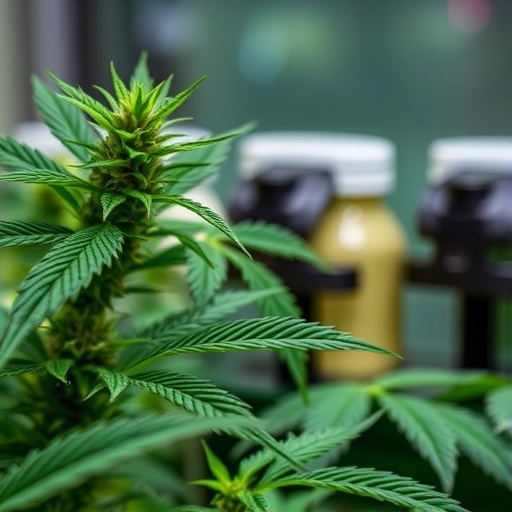Since its legalization for medical use in Utah in 2020, medical cannabis has become an increasingly prevalent option for patients grappling with complex and often treatment-resistant conditions such as post-traumatic stress disorder (PTSD) and chronic pain. Patients who obtain a medical cannabis card gain access to a regulated market where products are available through licensed pharmacies, ensuring that the cannabis they consume meets stringent safety and quality standards. However, a concerning trend has emerged whereby a notable portion of these individuals opt instead for unregulated cannabis products. This decision introduces significant health risks due to the lack of oversight, potential contamination, and inconsistent cannabinoid levels in illicit cannabis.
A recent exploratory survey conducted with over 200 participants enrolled in Utah’s medical cannabis program sheds light on the underlying reasons driving the use of illicit cannabis despite the availability of legally sourced alternatives. This research, published in the Journal of Cannabis Research, provides a pivotal analysis aimed at understanding patient behaviors and barriers within the program, crucial for informing policy and healthcare approaches that promote safer cannabis consumption.
One of the most critical barriers identified is the prohibitively high cost associated with obtaining legal cannabis products. The regulatory frameworks that ensure cannabis product safety require robust quality control measures, licensing fees, and distribution systems, all of which contribute to increased costs for the end consumer. For patients already struggling with chronic health conditions, which often impair their ability to maintain consistent employment, the financial burden becomes a significant deterrent. This economic reality drives many toward cheaper, unregulated cannabis sold through illicit channels despite the heightened risks.
Chronic illnesses such as chronic pain and PTSD not only motivate medical cannabis use but also exacerbate the economic dimension of healthcare access. The cyclical nature of economic hardship intertwined with health challenges means patients with limited financial resources may prioritize immediate affordability over long-term safety. This dynamic creates a paradoxical health disparity, where individuals in greatest need of medical cannabis for symptom relief are simultaneously the least able to afford regulated products, placing them at heightened risk of harm from inconsistent or contaminated illicit cannabis.
Without standardized quality assurance protocols regulating illicit cannabis products, patients face significant uncertainty and danger. Unregulated cannabis can vary widely in the concentration of key cannabinoids such as tetrahydrocannabinol (THC) and cannabidiol (CBD), leading to unpredictable therapeutic outcomes and potential adverse effects. Furthermore, these products may contain undetected additives or harmful contaminants, including pesticides, molds, or heavy metals, that can exacerbate underlying health conditions or introduce new health complications.
The study’s senior author, Jerry Cochran, PhD, professor of epidemiology and director of the Program for Addiction Research, Clinical Care, Knowledge, and Advocacy (PARCKA) at the University of Utah, articulates the complexities facing patients: “It’s a catch-22 where the very conditions limiting a patient’s work capacity also restrict their financial ability to purchase safer, regulated cannabis products, potentially worsening their health.”
Given the nascent status of Utah’s medical cannabis program, research such as this is essential in fostering accountability and targeted improvements. Lirit Franks, PhD, research development associate in PARCKA and a contributing author, emphasizes the importance of evidence-based evaluations: “Insight into patient experiences highlights both successes and systemic obstacles within the program, guiding future research and program refinement to better serve patient needs.”
Beyond addressing cost barriers, the dissemination of accurate and unbiased information emerges as a vital factor influencing patient choices toward safe cannabis use. The survey found that individuals who primarily consult the official state medical cannabis website are more likely to utilize licensed products, underscoring the power of informed decision-making. This contrasts sharply with reliance on commercial marketing or informal sources that may skew perceptions and inadvertently promote illicit product use.
“The removal of bias and provision of clear, factual information empowers patients to make safer choices within the medical cannabis program,” notes Cochran. This insight provides a compelling case for healthcare providers and policymakers to invest in accessible educational resources and transparent communication channels that demystify medical cannabis and its regulatory landscape.
To enhance patient safety further, the study advocates for strategic interventions that reduce financial and procedural impediments to accessing legal cannabis. One such recommendation involves lowering the fees associated with renewing medical cannabis cards, which may ease continuity in patients’ use of regulated products and prevent lapses that push them toward illicit alternatives.
Ultimately, the researchers emphasize the need for a multifaceted approach that integrates economic support, patient education, and system-level reforms. By attentively addressing obstacles identified through patient experiences, Utah’s medical cannabis program can evolve to better fulfill its dual mandate of symptom relief and harm reduction.
This study offers a critical foundation for subsequent research and policy action, spotlighting the nuanced realities of medical cannabis access. In doing so, it contributes to a broader understanding of health disparities rooted in socioeconomic factors and regulatory frameworks, with implications extending beyond cannabis to other areas of healthcare where cost and information barriers impact patient outcomes.
As medical cannabis programs expand nationwide and globally, lessons from Utah’s experience stress the importance of coupling legalization with patient-centered strategies that prioritize safety, affordability, and knowledge. Without such comprehensive measures, vulnerable patient populations risk being sidelined into dangerous avenues of care that undermine the therapeutic potential of cannabis.
Subject of Research: People
Article Title: Understanding motives for illicit medicinal cannabis use: an exploratory analysis in a medical cannabis program
News Publication Date: 18-Jul-2025
Web References: https://jcannabisresearch.biomedcentral.com/articles/10.1186/s42238-025-00284-w
Image Credits: Kristan Jacobsen Photography / University of Utah Health
Keywords: Cannabis, Illicit drugs, Health care policy, Medications




